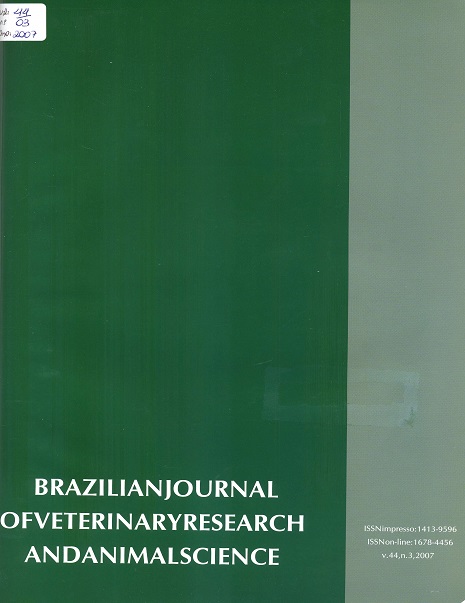Chronic copper poisoning in sheep grazed under grape orchard fertilise with poultry litter
DOI:
https://doi.org/10.11606/issn.1678-4456.bjvras.2007.26640Keywords:
Sheep, Chronic, Copper poisoning, Poultry litter, Crushing grapes husksAbstract
This work describe dead due to chronic copper poisoning (CCP) that occurred in a flock of sheep grazed under grape orchard, located at the hilly area of southern Brazil; supplemented with concentrate and crushing grapes husks. The orchard was annually sprayed with 2 per cent copper sulphate and the ground fertilised with poultry litter. The sheep showed depression, jaundice and hemoglobinuria. Fourteen sheep died, representing 57 per cent of the flock. The clinical sign, necropsy and microscopic findings were typical of CCP. The serum level of aspartate aminotrasferase (AST) of remain six sheep, varied from 48.8 to 403.3 IU/L. The cooper level found in the poultry litter, crushing grapes husks, grass and concentrate were 637, 158, 86 and 18 mg/kg, respectively. It is concluded that the sheep losses occurred due to the high level of copper found in the pasture, crushing grapes husks and concentrate fed to the animals. It is also suggested, the environmental risk of poultry litter as fertiliser of sheep pasture as well as the use of crushing grapes husks as sheep supplemental feeding.Downloads
Download data is not yet available.
Downloads
Published
2007-06-01
Issue
Section
UNDEFINIED
License
The journal content is authorized under the Creative Commons BY-NC-SA license (summary of the license: https://
How to Cite
1.
Ribeiro LAO, Rodrigues NC, Smiderle WA. Chronic copper poisoning in sheep grazed under grape orchard fertilise with poultry litter. Braz. J. Vet. Res. Anim. Sci. [Internet]. 2007 Jun. 1 [cited 2024 Apr. 19];44(3):208-11. Available from: https://revistas.usp.br/bjvras/article/view/26640





